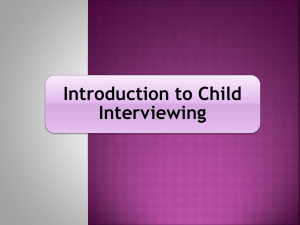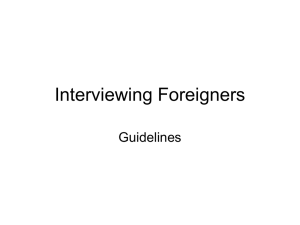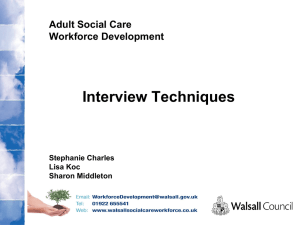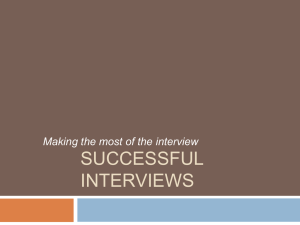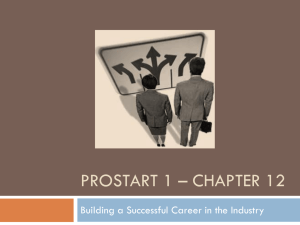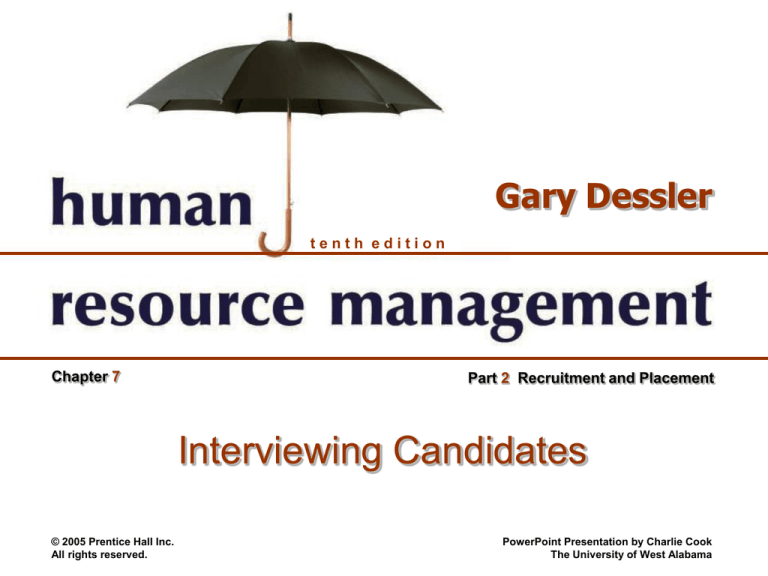
Gary Dessler
tenth edition
Chapter 7
Part 2 Recruitment and Placement
Interviewing Candidates
© 2005 Prentice Hall Inc.
All rights reserved.
PowerPoint Presentation by Charlie Cook
The University of West Alabama
After studying this chapter,
you should be able to:
1. List the main types of selection interviews.
2.
Explain and illustrate at least six factors that affect
the usefulness of interviews.
3. Explain and illustrate each guideline for being a
more effective interviewer.
4.
Effectively interview a job candidate.
© 2005 Prentice Hall Inc. All rights reserved.
7–2
Basic Features of Interviews
An interview
– A procedure designed to obtain information from a
person through oral responses to oral inquiries
Types of interviews
– Selection interview
– Appraisal interview
– Exit interview
Interviews formats
– Structured
– Unstructured
© 2005 Prentice Hall Inc. All rights reserved.
7–3
Types of Interviews
Selection interview
– A selection procedure designed to predict future
job performance on the basis of applicants’ oral
responses to oral inquiries.
Appraisal interview
– A discussion, following a performance appraisal, in
which supervisor and employee discuss the
employee’s rating and possible remedial actions.
Exit interview
– An interview to elicit information about the job or
related matters to the employer some insight into
what’s right or wrong about the firm.
© 2005 Prentice Hall Inc. All rights reserved.
7–4
Formats of Interviews
Unstructured or nondirective interview
– An unstructured conversational-style interview in
which the interviewer pursues points of interest as
they come up in response to questions.
Structured or directive interview
– An interview following a set sequence of
questions.
© 2005 Prentice Hall Inc. All rights reserved.
7–5
Interview Content: Types of Questions
Situational interview
– A series of job-related questions that focus on
how the candidate would behave in a given
situation.
Behavioral interview
– A series of job-related questions that focus on
how they reacted to actual situations in the past.
Job-related interview
– A series of job-related questions that focus on
relevant past job-related behaviors.
© 2005 Prentice Hall Inc. All rights reserved.
7–6
Structured
Interview
Guide
Source: Copyright 1992. The
Dartnell Corporation, Chicago, IL.
Adapted with permission.
Figure 7–1a
© 2005 Prentice Hall Inc. All rights reserved.
7–7
Structured
Interview
Guide
(cont’d)
Source: Copyright 1992. The
Dartnell Corporation, Chicago, IL.
Adapted with permission.
Figure 7–1b
© 2005 Prentice Hall Inc. All rights reserved.
7–8
Structured
Interview
Guide
(cont’d)
Source: Copyright 1992. The
Dartnell Corporation, Chicago, IL.
Adapted with permission.
Figure 7–1c
© 2005 Prentice Hall Inc. All rights reserved.
7–9
HR Scorecard
for Hotel Paris
International
Corporation*
Note: *(An abbreviated example showing selected
HR practices and outcomes aimed at implementing
the competitive strategy, “To use superior guest
services to differentiate the Hotel Paris properties
and thus increase the length of stays and the return
rate of guests and thus boost revenues and
profitability”)
Figure 7–2
© 2005 Prentice Hall Inc. All rights reserved.
7–10
Interview Content: Types of Questions
Stress interview
– An interview in which the interviewer seeks to
make the applicant uncomfortable with
occasionally rude questions that supposedly to
spot sensitive applicants and those with low or
high stress tolerance.
Puzzle questions
– Recruiters for technical, finance, and other types
of jobs use questions to pose problems requiring
unique (“out-of-the-box”) solutions to see how
candidates think under pressure.
© 2005 Prentice Hall Inc. All rights reserved.
7–11
Personal or Individual Interviews
Unstructured sequential interview
– An interview in which each interviewer forms an
independent opinion after asking different
questions.
Structured sequential interview
– An interview in which the applicant is interviewed
sequentially by several persons; each rates the
applicant on a standard form.
Panel interview
– An interview in which a group of interviewers
questions the applicant.
© 2005 Prentice Hall Inc. All rights reserved.
7–12
Personal or Individual Interviews
Panel (broad) interview
– An interview in which a group of interviewers
questions the applicant.
Mass interview
– A panel interviews several candidates
simultaneously.
© 2005 Prentice Hall Inc. All rights reserved.
7–13
Computerized Interviews
Computerized selection interview
– An interview in which a job candidate’s oral and/or
computerized replies are obtained in response to
computerized oral, visual, or written questions
and/or situations.
Characteristics
– Reduces amount of time managers devote to
interviewing unacceptable candidates.
– Applicants are more honest with computers
– Avoids problems of interpersonal interviews
– Mechanical nature of computer-aided interview
can leave an applicant dissatisfied.
© 2005 Prentice Hall Inc. All rights reserved.
7–14
Factors Affecting Interviews
First impressions
– The tendency for interviewers to jump to
conclusions—make snap judgments—about
candidates during the first few minutes of the
interview.
– Negative bias: unfavorable information about an
applicant influences interviewers more than does
positive information.
© 2005 Prentice Hall Inc. All rights reserved.
7–15
Factors Affecting Interviews (cont’d)
Misunderstanding the job
– Not knowing precisely what the job entails and
what sort of candidate is best suited causes
interviewers to make decisions based on incorrect
stereotypes of what a good applicant is.
Candidate-order error
– An error of judgment on the part of the
interviewer due to interviewing one or more very
good or very bad candidates just before the
interview in question.
© 2005 Prentice Hall Inc. All rights reserved.
7–16
Factors Affecting Interviews (cont’d)
Nonverbal behavior and impression
management
– Interviewers’ inferences of the interviewee’s
personality from the way he or she acts in the
interview have a large impact on the interviewer’s
rating of the interviewee.
– Clever interviewees attempt to manage the
impression they present to persuade interviewers
to view them more favorably.
© 2005 Prentice Hall Inc. All rights reserved.
7–17
Factors Affecting Interviews (cont’d)
Effect of personal characteristics:
attractiveness, gender, race
– Interviewers tend have a less favorable view of
candidates who are:
• Physically unattractive
• Female
• Of a different racial background
• Disabled
© 2005 Prentice Hall Inc. All rights reserved.
7–18
Factors Affecting Interviews (cont’d)
Interviewer behaviors affecting interview
outcomes
– Inadvertently telegraphing expected answers.
– Talking so much that applicants have no time to
answer questions.
– Letting the applicant dominate the interview.
– Acting more positively toward a favored (or similar
to the interviewer) applicant.
© 2005 Prentice Hall Inc. All rights reserved.
7–19
Designing and Conducting the Interview
The structured situational interview
– Use either situational questions (preferred) or
behavioral questions that yield high criteria-related
validities.
– Step 1: Job Analysis
– Step 2: Rate the Job’s Main Duties
– Step 3: Create Interview Questions
– Step 4: Create Benchmark Answers
– Step 5: Appoint the Interview Panel and Conduct
Interviews
© 2005 Prentice Hall Inc. All rights reserved.
7–20
How to Conduct an Effective Interview
Structure your interview:
1. Base questions on actual job duties.
2. Use job knowledge, situational, or behaviorally oriented
questions and objective criteria to evaluate the
interviewee’s responses.
3. Train interviewers.
4. Use the same questions with all candidates.
5. Use descriptive rating scales (excellent, fair, poor) to rate
answers.
6. Use multiple interviewers or panel interviews.
7. If possible, use a standardized interview form.
8. Control the interview.
9. Take brief, unobtrusive notes during the interview.
© 2005 Prentice Hall Inc. All rights reserved.
7–21
Examples of Questions That Provide Structure
Situational Questions:
1. Suppose a co-worker was not following standard work procedures. The co-worker was
more experienced than you and claimed the new procedure was better. Would you use the
new procedure?
2. Suppose you were giving a sales presentation and a difficult technical question arose that
you could not answer. What would you do?
Past Behavior Questions:
3. Based on your past work experience, what is the most significant action you have ever taken
to help out a co-worker?
4. Can you provide an example of a specific instance where you developed a sales
presentation that was highly effective?
Background Questions:
5. What work experiences, training, or other qualifications do you have for working in a
teamwork environment?
6. What experience have you had with direct point-of-purchase sales?
Job Knowledge Questions:
7. What steps would you follow to conduct a brainstorming session with a group of employees
on safety?
8. What factors should you consider when developing a television advertising campaign?
Note: So that direct comparisons can be made, an example is presented to assess
both teamwork (1,3,5,7) and sales attributes (2,4,6,8) for each type of question.
Source: Michael Campion, David Palmer, and James Campion, “A Review of
Structure in the Selection Interview,” Personnel Psychology (1997), p. 668.
© 2005 Prentice Hall Inc. All rights reserved.
Figure 7–3
7–22
How to Conduct an Effective Interview
(cont’d)
Prepare for the interview
– Secure a private room to minimize interruptions.
– Review the candidate’s application and résumé.
– Review the job specifications
Establish rapport
– Put the person at ease.
Ask questions
– Follow your list of questions.
– Don’t ask questions that can be answered yes or
no.
© 2005 Prentice Hall Inc. All rights reserved.
7–23
Key Terms
Unstructured or nondirective
Interview
Structured or directive interview
Situational interview
Behavioral interviews
Job-related interview
Stress interview
Unstructured sequential interview
Structured sequential interview
Panel interview
Mass interview
Candidate-order error
© 2005 Prentice Hall Inc. All rights reserved.
7–24

